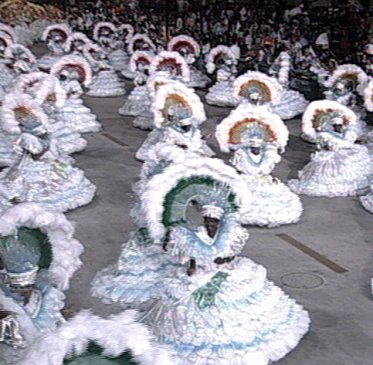 |
usa | world | animals | vocabulary | health | science | math | history |
Carnival
A carnival parade is a public celebration, combining some elements of a circus and public street party, generally during the Carnival Season. Carnival is mostly a tradition of long-time Roman Catholic and, to a lesser extent, Christian Orthodox areas of the world. Most Protestant and non-Christian areas do not celebrate it.
The Carnival Season is a holiday period during the two weeks before the traditional Christian fast of Lent. The origin of the name "Carnival" is unclear as there are several theories. The most commonly known theory states that the name comes from the Italian carne- or carnovale, from Latin carnem (meat) + levare (lighten or raise), literally "to remove the meat" or "stop eating meat". It has also been claimed that it comes from the Latin words caro (meat) and vale (farewell), hence "Farewell to meat". Yet another theory states that it originates from the Latin carrus navalis, which was some kind of Greek cart carrying a statue of a god in a religious procession at the annual festivities in honour of the god Apollo. Most commonly the season began on Septuagesima, the third from the last Sunday before Ash Wednesday, but in some places it started as early as Twelfth Night, continuing until Lent. This period of celebration and partying had its origin in the need to use up all remaining meat and animal products such as eggs and butter before the fasting season. The celebration of Carnival ends on "Mardi Gras" (French for "Fat Tuesday", meaning Shrove Tuesday), the day before Ash Wednesday, when the rigours of Lent's 40 days of fasting and sacrifice begin. It sometimes lasts until Piñata Weekend, the first Saturday and Sunday of Lent.

Carnival in Rio de Janerio
It is sometimes said that this festival came from Saturnalia, Saturn's festival, and Lupercalia. In the later Roman period, these festivals were characterized by wanton raillery and unbridled freedom, and were in a manner a temporary subversion of civil order. Historians think that this spirit was transmitted to the Carnival.
Another theory, esp. prominent in Switzerland probably predates Christianity. The festival was linked to the beginning of spring, and the idea behind Carnival was to scare evil spirits away. This is usually done with processions, where the participants wore horrible masks, and where everyone that could would make loud noises and music with whatever was available. Later on, the processions were devoted to Patron-saints, the two most prominent being the virgin Mary or the Saint the local church was christened to.
In ancient times, carnival was held to begin on 6th January and lasted until midnight of Shrove Tuesday. Some believe that this period of license represents the kind of compromise the church tended to make with pagan festivals and that carnival really represents the Roman Saturnalia. Rome has always been the headquarters of carnival, and though some popes, notably Clement IX and XI and Benedict XIII, made efforts to stem the tide of Bacchanalian revelry, many of the popes were great patrons and promoters of carnival-keeping.
The Brazilian Carnival is an annual celebration, celebrated forty days before Easter (marking the start of Lent), in Brazil. It has some differences from its counterparts in Europe, as well there being variations across the large Brazilian territory. The Brazilian Carnival is known in Brazil simply as "carnaval".
Despite the Catholic inspiration, Brazilian Carnival is celebrated more as a profane feast than a religious event. Its origins are European, by a kind of carnival called Introito (Latin for entrance). The entrudo, as it was known in Brazil, could have been characterized mainly as a joke: to throw water (and later, other things) in other people, to "purify the body". The entrudo was prohibited, without success, in middle of the 19th Century, as it was considered violent by the upper classes (it is told that many people died from infections and other diseases, since even rotten fruits were sometimes thrown).
In the late 19th Century, the cordões (literally "laces" in Portuguese) were introduced in Rio de Janeiro, which consisted of groups of people that would walk on the streets playing music and dancing. The cordões were ancestors of the modern samba's school.
The blocos (blocks), another name for the cordões, are some of the current representations of the popular Brazilian Carnival. They are formed by people who dress in costumes according to certain themes, or to celebrate the carnival in specific ways. The schools of samba are truly organizations that work all year in order to prepare themselves for the samba schools parade.
The main festivity in Brazilian Carnival takes place in Rio de Janeiro, with its samba schools, blocos and bandas which occupy entire neighbourhoods. In some cities of the Northeastern Region, there is another form of the Brazilian Carnival: the Trio Elétrico. A trio elétrico is an adapted truck, with giant speakers and a platform where musicians play songs of local genres such as Axé music and Maracatu.
In La Ceiba in Honduras carnival is held on the third Saturday of every May to commemorate San Isidro, and is the largest in Central America.